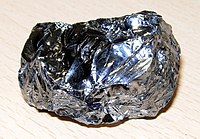
Photo from wikipedia
The present work aims to determine the influence of Glass Fiber-Reinforced Polymer (GFRP) laminating configuration in heat generation during the dry edge trimming process. Temperature measurement experiments were conducted on… Click to show full abstract
The present work aims to determine the influence of Glass Fiber-Reinforced Polymer (GFRP) laminating configuration in heat generation during the dry edge trimming process. Temperature measurement experiments were conducted on pure epoxy matrix, 15% unidirectional glass fiber reinforced epoxy, and 28% silica sand-filled GFRP specimens through eight type-K thermocouples evenly distributed along the trim plans and connected to a data acquisition system. Infrared thermographic measurements were also conducted to investigate the tool temperature evolution while processing. It was found that perpendicular fiber edge milling induces a sharp increase with peak temperature measurements reaching 119 °C, while machining parallel to fiber leads to a maximum temperature history of 41 °C, which is very close to that obtained from the pure epoxy test. It was also found that the addition of silica sand grains in the GFRP matrix reduces both tool and specimen temperature magnitudes up to 67% for 90° plies and 14% for 0° plies compared to silica sand-free composite initial values. The heat partition was calculated from the measured (electric) and estimated energies for the tool, the workpiece, and chips, respectively. It appears from predictions that the addition of silica sand grains increases the heat conductivity of the GFRP materials (with rates of 20% for 0° fiber orientation and 10% for 90° fiber direction), while it reduces that conducted to the milling tool. Scanning Electron Microscopy (SEM) inspections helped detect the dominating machining defects relative to each GFRP configuration and explained the heat generation and dissipation effects in light of peak temperature measurements.
Journal Title: Materials
Year Published: 2022
Link to full text (if available)
Share on Social Media: Sign Up to like & get
recommendations!